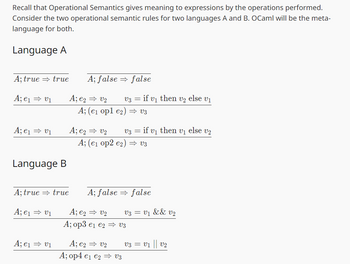
Programming Logic & Design Comprehensive
9th Edition
ISBN: 9781337669405
Author: FARRELL
Publisher: Cengage
expand_more
expand_more
format_list_bulleted
Question

Transcribed Image Text:What does (true opl (false op2 true)) evaluate to?
○ true
○ false

Transcribed Image Text:Recall that Operational Semantics gives meaning to expressions by the operations performed.
Consider the two operational semantic rules for two languages A and B. OCaml will be the meta-
language for both.
Language A
A; true true
A; false
false
A; e1 ⇒v1
A; e2 ⇒ V2
A; (e1 opl e2)
V3 =
if v₁ then V2 else V1
v3
A; e1⇒v1
A; e2 ⇒ V2 v3
if v₁ then v₁ else v₂
A; (e1 op2 e2)
v3
Language B
A; true true
A; false
=> false
A; e1 ⇒v1
A; e2 ⇒ V2
V3 = v₁ && v₂
A; op3 e₁ e2
V3
A; e1 ⇒v1
A; e2 ⇒ V2
v3 = v1 || v2
A; op4 e₁ e2 ⇒ V3
Expert Solution
This question has been solved!
Explore an expertly crafted, step-by-step solution for a thorough understanding of key concepts.
Step by stepSolved in 2 steps

Knowledge Booster
Similar questions
- Define sentence capitalization.arrow_forwardThe technique of packaging an objects attributes into a cohesive unit that can be used as an undivided entity is ____________. a. inheritance b. encapsulation c. polymorphism d. interfacingarrow_forwardThe grammar and spelling rules of a programming language constitute its _________. logic variables class syntaxarrow_forward
- Consider the definition of the class product Type as given in Exercise 8. Answer the following questions. (1, 2, 3, 5, 7) a. Write the definition of the function set so that instance variables are set according to the paramaters. Instance variables quantitieslnStock, price, and discount must be nonnegative. b. Write the definition of the function print to output the values of the instance variables. c Write the definition of the function setQuantitiesInStock to set the value of the instance variable quantitiesInStock according to the parameter. d. Write the definition of the function updateQuantitiesInStock to update the value of instance variable quantitiesInStock by adding the value of the parameter. e. Write the definition of the function getQuantitiesInStock to return the value of instance variable quantitiesInStock. f. Write the definition of the function setPrice to set the value of the instance variable price according to the parameter. g. Write the definition of the function getPrice to return the value of the instance variable price. h. Write the definition of the function setDiscount to set the value of the instance variable discount according to the parameter. i. Write the definition of the function getDiscount to return the value of the instance variable discount.arrow_forwardAssume the definition of class houseType as given in Exercise 11. Answer the following questions. (1, 2, 3, 5, 7) a. Write the definition of the member function set so that private members are set according to the parameters. b. Write the definition of the member function print that prints the values of the data members. c. Write the definition of the constructor of the class houseType so that the private member variables are initialized to according to the parameters. d. Write a C++ statement that prints the value of the object newHouse. e. Write a C + + statement that declares an object house of type newHouse, and initializes the member variables of house to "Ranch", 3, 2, 2, 2005, 1300, 185000, and 3600.0, respectively. f. Which function members are accessors and which are mutators?arrow_forward
arrow_back_ios
arrow_forward_ios
Recommended textbooks for you
- Programming Logic & Design ComprehensiveComputer ScienceISBN:9781337669405Author:FARRELLPublisher:Cengage
 EBK JAVA PROGRAMMINGComputer ScienceISBN:9781305480537Author:FARRELLPublisher:CENGAGE LEARNING - CONSIGNMENTNp Ms Office 365/Excel 2016 I NtermedComputer ScienceISBN:9781337508841Author:CareyPublisher:Cengage
EBK JAVA PROGRAMMINGComputer ScienceISBN:9781305480537Author:FARRELLPublisher:CENGAGE LEARNING - CONSIGNMENTNp Ms Office 365/Excel 2016 I NtermedComputer ScienceISBN:9781337508841Author:CareyPublisher:Cengage  C++ for Engineers and ScientistsComputer ScienceISBN:9781133187844Author:Bronson, Gary J.Publisher:Course Technology Ptr
C++ for Engineers and ScientistsComputer ScienceISBN:9781133187844Author:Bronson, Gary J.Publisher:Course Technology Ptr Programming with Microsoft Visual Basic 2017Computer ScienceISBN:9781337102124Author:Diane ZakPublisher:Cengage Learning
Programming with Microsoft Visual Basic 2017Computer ScienceISBN:9781337102124Author:Diane ZakPublisher:Cengage Learning

Programming Logic & Design Comprehensive
Computer Science
ISBN:9781337669405
Author:FARRELL
Publisher:Cengage

EBK JAVA PROGRAMMING
Computer Science
ISBN:9781305480537
Author:FARRELL
Publisher:CENGAGE LEARNING - CONSIGNMENT

Np Ms Office 365/Excel 2016 I Ntermed
Computer Science
ISBN:9781337508841
Author:Carey
Publisher:Cengage

C++ for Engineers and Scientists
Computer Science
ISBN:9781133187844
Author:Bronson, Gary J.
Publisher:Course Technology Ptr

Programming with Microsoft Visual Basic 2017
Computer Science
ISBN:9781337102124
Author:Diane Zak
Publisher:Cengage Learning
